Hill climbing diary by Helen Rose: Everest Base Camp
Everest Base Camp February 2001
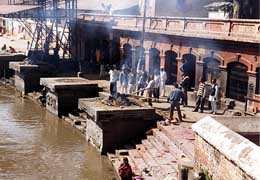
Having been a hill walker for many years, I had an interest in going to the Himalayas but visiting Everest Base Camp seemed beyond my ability until I noticed that most of the adventure holiday companies were featuring treks to Everest Base Camp as holidays. I thought I would give it a try and indeed it was an adventure camping at -14 degrees celsius, being breathless at high altitude, drinking five litres of water and eating 5,000 calories a day and above all seeing the highest mountain in the world only a few miles away!
The trek lasted fourteen days from Lukla and took nine days to reach the highest point and four days to return to Lukla. The ascent was much longer to allow time to acclimatise at altitude. There were fifteen of us from Britain including our wonderful leader Lucy Barclay plus the Sirdar (chief sherpa) and a team of cooks, sherpa guides, kitchen boys and girls, kitchen assistants, yak drivers and porters. There was a very strict pecking order in the team and I think I have listed them correctly in descending order but correct me by e-mailing helenrose52@hotmail.com if I am wrong.
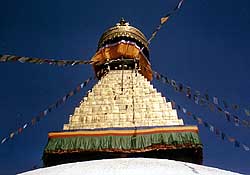
We were taken by helicopter from Kathmandu to Lukla and landed on a tiny airstrip on the side of a mountain. Sir Edmund Hillary's wife and daughter were killed in a plane crash there as there is very little room for error or adverse weather conditions on such a dangerous and limited location. The planes take off on the short airstrip into thin air as it is half way up a mountain. Everyone watches the take-offs as most people spend some time in Lukla preparing for treks or waiting for planes and there is not a lot to do there so this provides some entertainment. The helicopter was a Russian Sikorski complete with Russian pilot.
From Lukla at 9,000 feet, we walked to Phakding in hot sunshine. The path was very busy and we quickly learned to flatten ourselves against high ground to allow the yak trains to pass as there is a steep drop to the river and the yaks wobble with their heavy sideloads. At this low altitude, the yaks were breathing heavily and overheating as there was too much oxygen but they are very efficient at high altitudes. Dzos are a cross between mules and yaks and much better at lower altitudes.
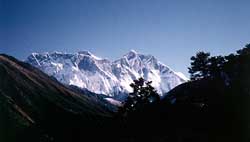
We camped at Phakding in heavy rain but it was camping for softies as the support team already had the tents erected and a fresh hot dinner prepared. Dinner was in a large communal tent where we played cards afterwards but went to our tents early as morning tea was normally brought to us about 6am.
The next day, it had stopped raining and we walked in brilliant sunshine to Namche Bazaar crossing fast flowing rivers by wire bridges which do not always look entirely safe and wobble a lot, especially if there are yaks on them. When we reached our lunch time stops, the kitchen crew had a hot lunch ready cooked on camping stoves. There were many Tibetans, as it was market day, and they had crossed passes at 20,000 feet to reach Namche. Although, a market town for the region there are no roads or airstrips and all travel is on foot or by mule.
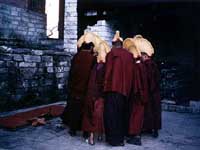
Namche is at 11,500 feet surrounded by mountains and we spent two nights there to acclimatise to the altitude. Lucy advised us to drink up to five litres of liquid a day to avoid altitude sickness.. Hygiene is another important consideration and handwashing before eating is an important consideration to avoid tummy problems. Even with these precautions, one of the group became very sick and the anti-biotics don't have any effect so sherpas have to put her in a basket on a mule and take her back to Lukla and on to Kathmandu. It is very cold out of the sun and down jackets have to be donned at sunset. Even in my 5 season sleeping bag, I feel cold so I buy a thermal sleeping bag liner and have no problems from then on.
Namche has a museum to the Sherpas and there are interesting photos of how the people survived including winding their hair across their eyes to prevent snow blindness. They are very serene and dignified people but the illiteracy rate especially for women is one of the highest in the world. The next morning we are up to see the sunrise and our first sight of Everest. Luckily, it is clear but I am more impressed by Ama Dablam which is only about 23,500 feet but a major climb. Today is the Hindu Festival of Diwali and the local children sing songs for us outside our tents. They are looking for sweets so it reminds me of Halloween.
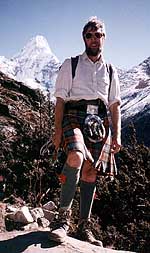
We said goodbye to flushing toilets and running water at Kathmandu so showers are now a distant memory and it is more important to keep warm and well. On the walk next day on the busy track to Tengboche I see an apparition - it is a man in a kilt and he tells me he was on an expedition to Ama Dablam but before the top he had a pulmonary oedama so had to abandon the climb as it would have been fatal to continue. He was from Edinburgh and very disappointed not to complete the climb but assured me he would be back. At Tengboche we are allowed a last beer as it is dangerous to drink at higher altitude and we visit the Buddhist Monastery in the early morning where the monks are gathered in a circle chanting and dressed in exotic yellow hats. We have wonderful views of Everest and are blessed with clear weather. It is hard to believe we are in the Himalayas and about thirty miles from Everest.
On to Dingboche and the terrain is changing with sparse vegetation.and snow at the side of the path. This is the Khumbu Valley and there is a hospital with electricity funded through Sir Edmund Hillary who is a well respected man in this region and still visits regularly. The hospital has doctors and these are volunteers who have short contracts. One serious health problem relates to broken limbs which have not been set so that problem has now been eradicated.
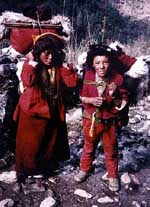
We continue to Labuche at 16,800 feet and we are now all feeling rotten with the altitude. Every step is an effort and packing up sleeping bags in the morning becomes a major task. We all lose our appetites and sleep badly but the kitchen staff continue to provide interesting meals and Lucy has even brought packet desserts from Britain to keep up our calorie intake. Although we have to eat high calory meals, we still lose weight due to altitude and trying to keep warm. I only just make it to Labuche at 17,000 feet where it is -14 C degrees overnight. My cold turns into a chest infection and although I am only 2 hours walk from the Everest Base Camp area, it is too dangerous to continue on as I must take anti- biotics and lose altitude as quickly as possible. As it is so cold we overnight in the lodge where it is very smoky as they are burning a mixture of yak dung and kerosene! Only six people, from our party, continued to the Base Camp area.
From now on it is downhill all the way and it is amazing how much better you feel as you lose altitude. Back in Kathmandu, there is a mad rush for the bathrooms as we had our first showers in two weeks! This is only a quick glimpse of the trip but I have a slide show and talk lasting about an hour which I can give to interested clubs around the Glasgow area if you e-mail me at helenrose52@hotmail.com
Coming attraction is some serious scrambling in Scotland and I will return from South America in March.
Thanks to Frances Rickus for the photographs.






